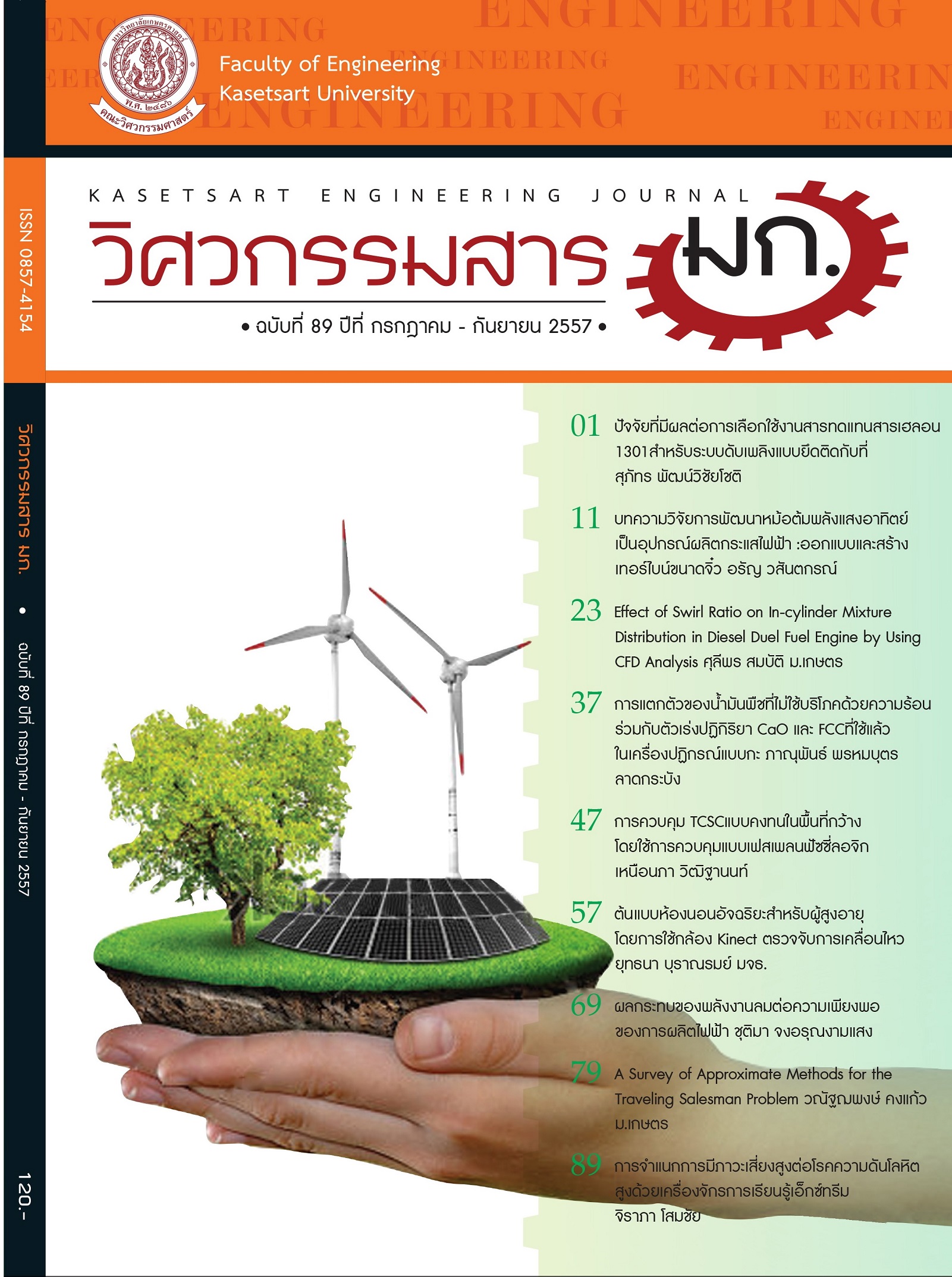การแตกตัวของน้ำมันพืชที่ไม่ใช้บริโภคด้วยความร้อนร่วมกับตัวเร่งปฏิกิริยา CaO และ FCC ที่ใช้แล้วในเครื่องปฏิกรณ์แบบกะ
Keywords:
thermal cracking, catalytic cracking, non edible oil, CaO, used FCCAbstract
งานวิจัยนี้ศึกษาการสังเคราะห์เชื้อเพลิงสังเคราะห์จากการแตกตัวของน้ำมันตุงด้วยความร้อนร่วมกับตัวเร่งปฏิกิริยาในเครื่องปฏิกรณ์แบบกะภายใต้บรรยากาศแก๊สไฮโดรเจน 1 บาร์เกจ น้ำมันตุงเป็นน้ำมันที่ไม่ใช้บริโภค โดยทั่วไปใช้ในงานเคลือบผิวไม้และโลหะ ตัวแปรที่ศึกษาซึ่งคาดว่ามีผลต่อร้อยละผลได้ (Yield) ของผลิตภัณฑ์เหลว และองค์ประกอบในผลิตภัณฑ์เหลว ได้แก่ ชนิดของตัวเร่งปฏิกิริยา (แคลเซียมออกไซด์ (CaO) และ FCC ที่ใช้แล้ว (Fluid catalytic cracking: FCC)) และอัตราส่วน โดยน้ำหนักของตัวเร่งปฏิกิริยา 1 - 3 wt% (0.1 - 0.3 กรัม ตัวเร่งปฏิกิริยาต่อน้ำมันตุง 10 กรัม) อุณหภูมิทำปฏิกิริยา 390, 415 และ 440 ๐ซ และเวลาทำปฏิกิริยา 30, 45 และ 60 นาที ภาวะที่เหมาะสมของแต่ละตัวเร่งปฏิกิริยาในการแตกตัวของน้ำมันตุง คือ ตัวเร่งปฏิกิริยา CaO 3 wt% ที่อุณหภูมิ 390 ๐ซ เวลา 30-45 นาที และตัวเร่งปฏิกิริยา FCC ที่ใช้แล้ว 1 wt% ที่อุณหภูมิ 390 ๐ซ เวลา 30 นาที ส่วนที่เป็นแก๊สของเหลว และของแข็งที่ได้จากการแตกตัวด้วยตัวเร่งปฏิกิริยา CaO ที่อุณหภูมิ 390 ๐ซ เวลา 30 นาที เท่ากับ 18.80, 76.50 และ 4.70 wt% และเมื่อใช้ตัวเร่งปฏิกิริยา FCC ที่ใช้แล้ว ที่อุณหภูมิ 390 ๐ซ เวลา 30 นาที เท่ากับ 19.80, 78.00 และ 2.20 wt% องค์ประกอบในผลิตภัณฑ์เหลววิเคราะห์ด้วยเครื่องแก๊สโครมาโทกราฟพร้อมซอฟต์แวร์จำลองการกลั่น (Simulated distillation gas chromatograph) ตามมาตรฐาน ASTM D2887 ซึ่งเป็นมาตรฐานที่ทดสอบการกระจายตัวของผลิตภัณฑ์ปิโตรเลียมตามคาบจุดเดือด ผลิตภัณฑ์เหลวที่ได้จากตัวเร่งปฏิกิริยา CaO ประกอบด้วยแกโซลีน 9.95 เคโรซีน 12.05 แก๊สออยล์เบา 22.95 แก๊สออยล์หนัก 4.78 และกากน้ำมันหนัก (Long residue หรือ Residue) 26.77 wt% ขององค์ประกอบทั้งหมด และที่ได้จากตัวเร่งปฏิกิริยา FCC ที่ใช้แล้ว ประกอบด้วยแกโซลีน 12.68 เคโรซีน 10.73 แก๊สออยล์เบา 23.40 แก๊สออยล์หนัก 4.67 และกากน้ำมันหนัก 26.52 wt% ขององค์ประกอบทั้งหมด
Thermal and catalytic cracking of non edible oil using CaO and used FCC catalysts in a batch reactor
In this work, synthetic fuels by thermal and catalytic cracking of Tung oil, a non edible oil for film coating on wood and metals, in a batch reactor at a constant hydrogen pressure of 1 barg was studied since non edible oils become more attractive alternative resource for synthetic fuels. The influences of types of catalysts (calcium oxide: CaO and used fluid catalytic cracking: FCC), the amounts of catalysts 1 - 3 wt% (0.1 - 0.3 g of the catalyst per 10 g of tung oil), reaction temperature of 390, 415 and 440 ๐C, and reaction time of 30, 45 and 60 minutes on liquid yield and its composition were investigated. The optimum cracking conditions were achieved from 3 wt% CaO catalyst at 390 ๐C and 30-45 min, and 1 wt% of used FCC catalyst at 390 ๐C and 30 min. As a result, by using CaO catalyst at 390 ๐C and 30 min, gas, liquid and solid fractions were found to be 18.80, 76.50 and 4.70 wt%, and by used FCC catalyst at 390 ๐C and 30 min were 19.80, 78.00 and 2.20 wt%. The composition distribution in liquid product was analyzed by the simulated distillation gas chromatograph according to ASTM D2887, which is the standard test method for the boiling-range distribution of petroleum fractions. The compositions of cracked liquid product from CaO catalyst were gasoline 9.95, kerosene 12.05, light gas oil 22.95, heavy gas oil 4.78 and long residue 26.77 wt% of total cracking. In case of used FCC catalyst, liquid product consisted of gasoline 12.68, kerosene 10.73, light gas oil 23.40, heavy gas oil 4.67 and long residue 26.52 wt% of total cracking.

